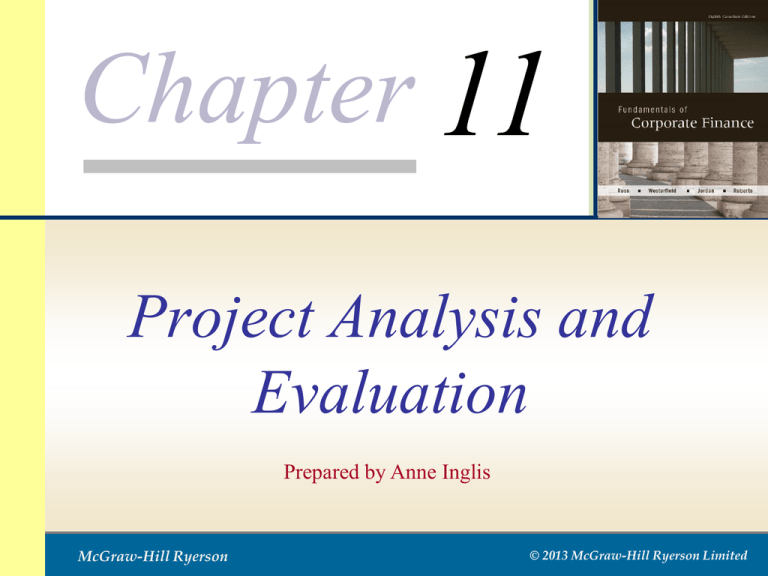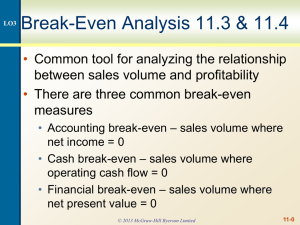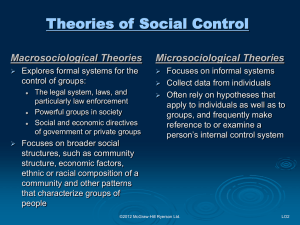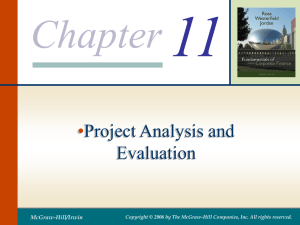RossFCF8ce_PPT_ch11
advertisement

Chapter 11 Project Analysis and Evaluation Prepared by Anne Inglis McGraw-Hill Ryerson © 2013 McGraw-Hill Ryerson Limited Key Concepts and Skills • Understand and be able to do scenario and sensitivity analysis • Know how to determine and interpret the cash, accounting and financial break-even points • Understand how the degree of operating leverage can affect the cash flows of a project • Understand how managerial options affect net present value • Know how capital rationing affects the ability of a company to accept projects © 2013 McGraw-Hill Ryerson Limited 11-1 Chapter Outline • • • • Evaluating NPV Estimates Scenario and Other What-If Analyses Break-Even Analysis Operating Cash Flow, Sales Volume, and Break-Even • Operating Leverage • Managerial Options • Capital Rationing © 2013 McGraw-Hill Ryerson Limited 11-2 LO1 Evaluating NPV Estimates 11.1 • The NPV estimates are just that – estimates • A positive NPV is a good start – now we need to take a closer look • Forecasting risk – how sensitive is our NPV to changes in the cash flow estimates? The more sensitive, the greater the forecasting risk • Sources of value – why does this project create value? © 2013 McGraw-Hill Ryerson Limited 11-3 LO1 Scenario Analysis 11.2 • What happens to the NPV under different cash flow scenarios? • At the very least look at: • Best case – revenues are high and costs are low • Worst case – revenues are low and costs are high • Measure of the range of possible outcomes • While best case and worst case are not necessarily probable, they can still be possible © 2013 McGraw-Hill Ryerson Limited 11-4 LO1 & New Project Example LO2 • Consider the project discussed in the text • The initial cost is $200,000 and the project has a 5-year life. There is no salvage. Depreciation is straight-line, the required return is 12% and the tax rate is 34% • The base case NPV is 15,567 © 2013 McGraw-Hill Ryerson Limited 11-5 LO2 Summary of Scenario Analysis Scenario Net Income Cash Flow NPV IRR Base Case 19,800 59,800 15,567 15.1% Worst Case -15,510 24,490 -111,719 -14.4% Best Case 59,730 99,730 159,504 40.9% © 2013 McGraw-Hill Ryerson Limited 11-6 LO1 Sensitivity Analysis • What happens to NPV when we vary one variable at a time • This is a subset of scenario analysis where we are looking at the effect of specific variables on NPV • The greater the volatility in NPV in relation to a specific variable, the larger the forecasting risk associated with that variable and the more attention we want to pay to its estimation © 2013 McGraw-Hill Ryerson Limited 11-7 LO1 Summary of Sensitivity Analysis for New Project Scenario Unit Sales Cash Flow NPV IRR Base case 6000 59,800 15,567 15.1% Worst case 5500 53,200 -8,226 10.3% Best case 6500 66,400 39,357 19.7% © 2013 McGraw-Hill Ryerson Limited 11-8 LO1 & LO2 Simulation Analysis • Simulation is really just an expanded sensitivity and scenario analysis • Monte Carlo simulation can estimate thousands of possible outcomes based on conditional probability distributions and constraints for each of the variables • The output is a probability distribution for NPV with an estimate of the probability of obtaining a positive net present value • The simulation only works as well as the information that is entered and very bad decisions can be made if care is not taken to analyze the interaction between variables © 2013 McGraw-Hill Ryerson Limited 11-9 LO1 & LO2 Making A Decision • Beware “Paralysis of Analysis” • At some point you have to make a decision • If the majority of your scenarios have positive NPVs, then you can feel reasonably comfortable about accepting the project • If you have a crucial variable that leads to a negative NPV with a small change in the estimates, then you may want to forego the project © 2013 McGraw-Hill Ryerson Limited 11-10 LO3 Break-Even Analysis 11.3 & 11.4 • Common tool for analyzing the relationship between sales volume and profitability • There are three common break-even measures • Accounting break-even – sales volume where net income = 0 • Cash break-even – sales volume where operating cash flow = 0 • Financial break-even – sales volume where net present value = 0 © 2013 McGraw-Hill Ryerson Limited 11-11 Example: Costs LO3 • There are two types of costs that are important in breakeven analysis: variable and fixed • Total variable costs = cost per unit * quantity = v*Q • Fixed costs are constant, regardless of output, over some time period • Total costs = fixed + variable = FC + v*Q • Example: • Your firm pays $3000 per month in fixed costs. You also pay $15 per unit to produce your product. • What is your total cost if you produce 1000 units? • What if you produce 5000 units? © 2013 McGraw-Hill Ryerson Limited 11-12 LO3 Average vs. Marginal Cost • Average Cost • TC / # of units • Will decrease as # of units increases • Marginal Cost • The cost to produce one more unit • Same as variable cost per unit • Example: What is the average cost and marginal cost under each situation in the previous example • Produce 1000 units: Average = 18,000 / 1000 = $18 • Produce 5000 units: Average = 78,000 / 5000 = 11-13 $15.60 © 2013 McGraw-Hill Ryerson Limited LO3 Accounting Break-Even • The quantity that leads to a zero net income • NI = (Sales – VC – FC – D)(1 – T) = 0 • QP – vQ – FC – D = 0 • Q(P – v) = FC + D • Q = (FC + D) / (P – v) © 2013 McGraw-Hill Ryerson Limited 11-14 LO3 Using Accounting Break-Even • Accounting break-even is often used as an early stage screening number • If a project cannot break-even on an accounting basis, then it is not going to be a worthwhile project • Accounting break-even gives managers an indication of how a project will impact accounting profit © 2013 McGraw-Hill Ryerson Limited 11-15 LO3 Accounting Break-Even and Cash Flow • We are more interested in cash flow than we are in accounting numbers • As long as a firm has non-cash deductions, there will be a positive cash flow • If a firm just breaks-even on an accounting basis, cash flow = depreciation • If a firm just breaks-even on an accounting basis, NPV < 0 © 2013 McGraw-Hill Ryerson Limited 11-16 LO3 Breakeven Example • Consider the following project • A new product requires an initial investment of $5 million and will be depreciated straight line to an expected salvage of zero over 5 years • The price of the new product is expected to be $25,000 and the variable cost per unit is $15,000 • The fixed cost is $1 million • What is the accounting break-even point each year? • Depreciation = 5,000,000 / 5 = 1,000,000 • Q = (1,000,000 + 1,000,000)/(25,000 – 15,000) = 200 units © 2013 McGraw-Hill Ryerson Limited 11-17 LO3 Breakeven Example continued • What is the operating cash flow at the accounting break-even point (ignoring taxes)? • OCF = (S – VC – FC - D) + D • OCF = (200*25,000 – 200*15,000 – 1,000,000) + 1,000,000 = 1,000,000 • What is the cash break-even quantity? • OCF = [(P-v)Q – FC – D] + D = (P-v)Q – FC • Q = (OCF + FC) / (P – v) • Q = (0 + 1,000,000) / (25,000 – 15,000) = 100 units © 2013 McGraw-Hill Ryerson Limited 11-18 LO3 Breakeven Example continued • What is the financial breakeven quantity? • • • • Assume a required return of 18% Accounting break-even = 200 Cash break-even = 100 What is the financial break-even point? • Similar process to finding the bid price • What OCF (or payment) makes NPV = 0? – N = 5; PV = 5,000,000; I/Y = 18; CPT PMT = 1,598,889 = OCF • Q = (1,000,000 + 1,598,889) / (25,000 – 15,000) = 260 units • The question now becomes: Can we sell at least 260 units per year? © 2013 McGraw-Hill Ryerson Limited 11-19 LO3 Three Types of Break-Even Analysis • Accounting Break-even • Where NI = 0 • Q = (FC + D)/(P – v) • Cash Break-even • Where OCF = 0 • Q = (FC + OCF)/(P – v) (ignoring taxes) • Financial Break-even • Where NPV = 0 • Cash BE < Accounting BE < Financial BE © 2013 McGraw-Hill Ryerson Limited 11-20 LO4 Operating Leverage 11.5 • Operating leverage is the relationship between sales and operating cash flow • Degree of operating leverage measures this relationship • The higher the DOL, the greater the variability in operating cash flow • The higher the fixed costs, the higher the DOL • DOL depends on the sales level you are starting from • DOL = 1 + (FC / OCF) © 2013 McGraw-Hill Ryerson Limited 11-21 LO4 Example: DOL • Consider the previous example • Suppose sales are 300 units • This meets all three break-even measures • What is the DOL at this sales level? • OCF = (25,000 – 15,000)*300 – 1,000,000 = 2,000,000 • DOL = 1 + 1,000,000 / 2,000,000 = 1.5 © 2013 McGraw-Hill Ryerson Limited 11-22 LO4 Example: DOL continued • What will happen to OCF if unit sales increases by 20%? • Percentage change in OCF = DOL*Percentage change in Q • Percentage change in OCF = 1.5(.2) = .3 or 30% • OCF would increase to 2,000,000(1.3) = 2,600,000 © 2013 McGraw-Hill Ryerson Limited 11-23 LO5 Managerial Options 11.6 • Planning for different contingencies • Option to expand • Option to abandon • Option to wait © 2013 McGraw-Hill Ryerson Limited 11-24 LO6 Capital Rationing 11.7 • Capital rationing occurs when a firm or division has limited resources • Soft rationing – the limited resources are temporary, often self-imposed • Hard rationing – capital will never be available for this project • The profitability index is a useful tool when faced with soft rationing © 2013 McGraw-Hill Ryerson Limited 11-25 Quick Quiz • What is sensitivity analysis, scenario analysis and simulation? • Why are these analyses important and how should they be used? • What are the three types of break-even and how should each be used? • What is degree of operating leverage? • What are some of the options that managers might consider when evaluating a project? • What is the difference between hard rationing and soft rationing? © 2013 McGraw-Hill Ryerson Limited 11-26 Summary 11.8 • You should know: • Forecasting risk results from estimates made in the NPV analysis • Scenario, sensitivity and simulation analysis are useful tools for dealing with forecasting risk • Breakeven analysis helps to identify critical levels of sales • Operating leverage reflects the degree to which operating cash flows are sensitive to changes in sales volume • Projects usually have future managerial options • Capital rationing happens when profitable projects cannot be accepted © 2013 McGraw-Hill Ryerson Limited 11-27 Homework • 1, 5, 9, 26, 28, 29 11-28






